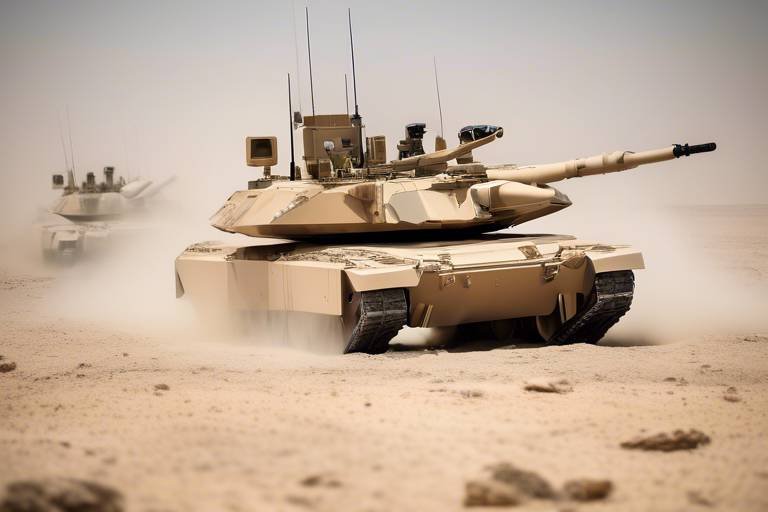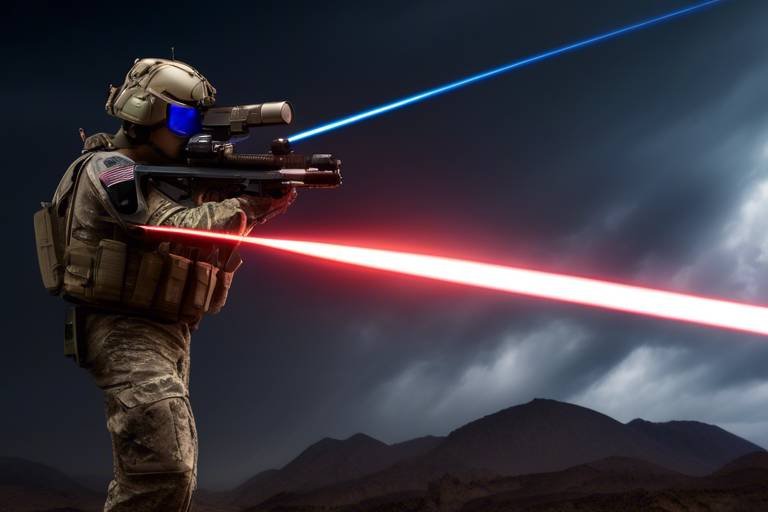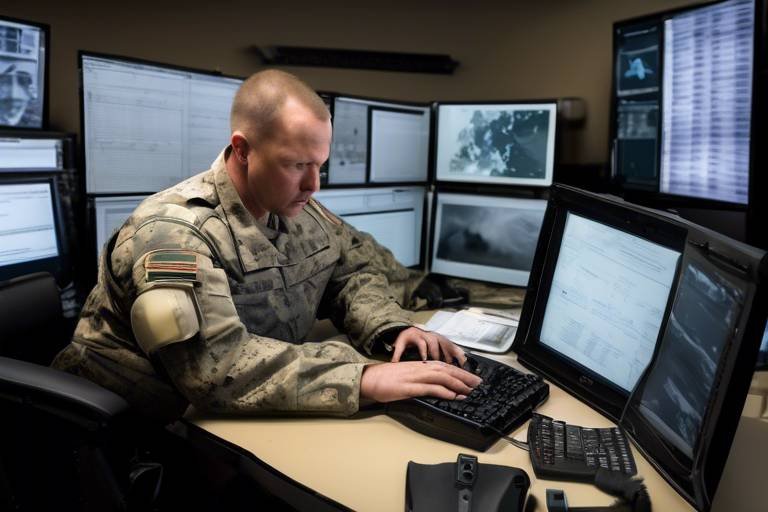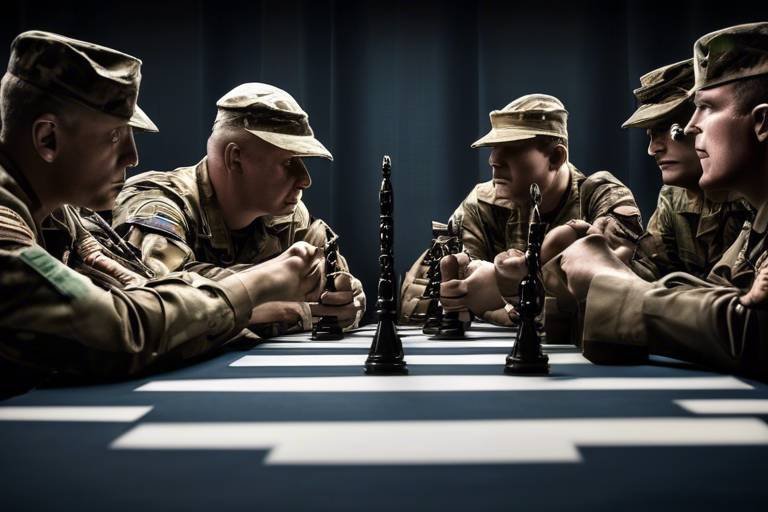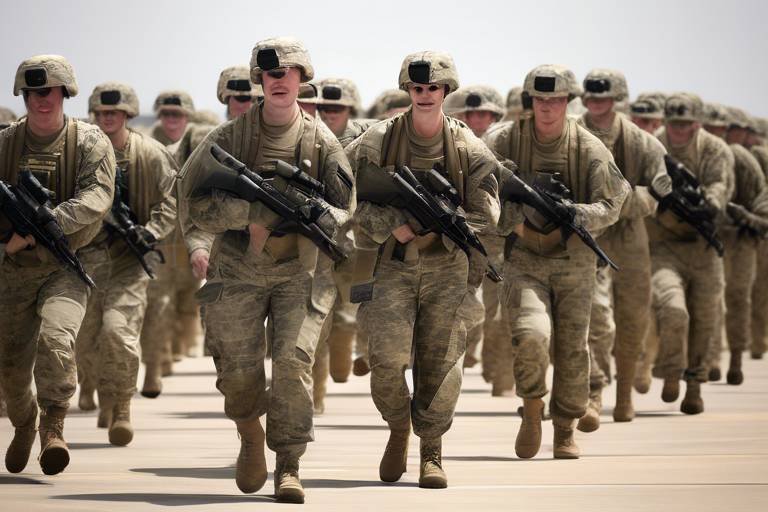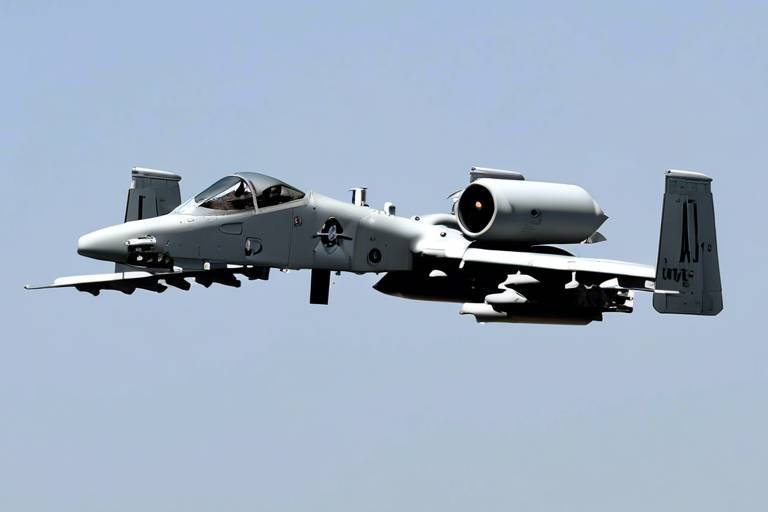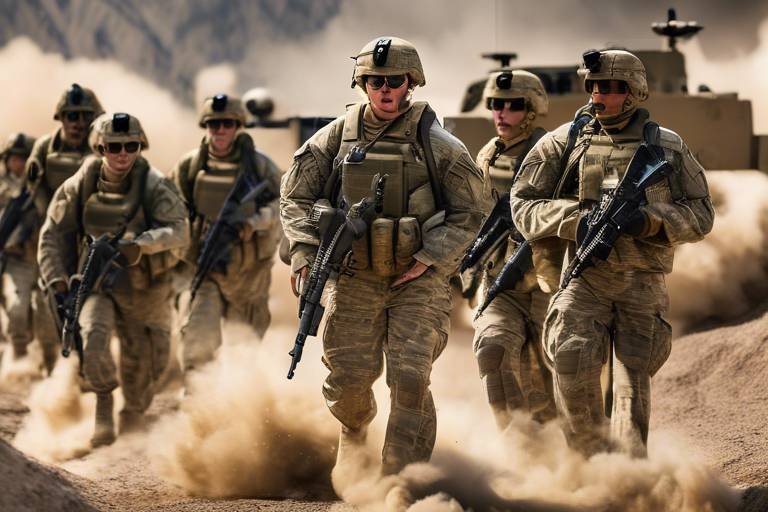How Advanced Defense Systems Address Emerging Global Threats
In a world where threats evolve at lightning speed, advanced defense systems stand as the bulwark against chaos. Imagine a chess game where the opponent not only changes strategies but also the rules mid-play; that's the reality of contemporary global security. From cyber warfare to hybrid tactics, the challenges we face today require not just strong military might but also innovative technologies and smart strategies. This article explores how these sophisticated systems are designed to counter new global threats, ensuring that nations remain secure and resilient in the face of uncertainty.
The journey of defense technologies is akin to a thrilling movie plot, filled with twists, turns, and groundbreaking innovations. From the rudimentary catapults of ancient times to today's cutting-edge drones and missile defense systems, each advancement has been a response to the shifting landscape of warfare. The development of radar technology during World War II, for instance, revolutionized air defense, while the advent of satellite technology has transformed reconnaissance and communication. These milestones have not only shaped military capabilities but have also set the stage for addressing the complexities of modern threats.
In an age where information can be weaponized, cybersecurity measures are paramount in defense strategies. Think of military operations as a well-guarded vault; if the vault's security is compromised, everything inside is at risk. Advanced defense systems now incorporate robust cybersecurity protocols to protect sensitive information from digital intrusions. This includes encryption technologies, real-time monitoring systems, and incident response teams that work tirelessly to thwart potential cyberattacks. By ensuring the integrity of military operations, these measures safeguard not only national security but also the trust of allied nations.
Nation-states have become increasingly sophisticated in their approaches to warfare, often utilizing a blend of traditional military force and modern technology. The challenges posed by these actors are multifaceted, requiring an evolution in defense systems that can adapt to their capabilities and strategies. For example, countries like Russia and China have invested heavily in cyber capabilities, leading to a new arms race in the cyber domain. As these nation-states deploy advanced technologies, the need for equally advanced defense systems becomes crucial to counteract their actions effectively.
Hybrid warfare is like a complex recipe that combines various ingredients—conventional forces, guerrilla tactics, cyber attacks, and misinformation campaigns. This method of warfare challenges traditional military responses, prompting the need for innovative defense strategies. Advanced defense systems are now designed to operate across multiple domains, integrating land, air, sea, and cyber capabilities to counter these mixed tactics. By understanding the nuances of hybrid warfare, military leaders can craft more effective responses that neutralize threats before they escalate.
The role of intelligence and surveillance in modern defense cannot be overstated. Picture a detective piecing together clues to solve a mystery; similarly, military intelligence relies on various technologies to gather, analyze, and act on information. Innovations such as drone surveillance, satellite imaging, and AI-driven analytics have enhanced situational awareness, allowing for quicker and more informed decision-making. These advancements ensure that defense systems are not only reactive but also proactive, staying one step ahead of potential threats.
The unpredictable nature of non-state actors and terrorist organizations poses a unique challenge to national security. Unlike traditional military forces, these groups often operate in shadows, making them difficult to track and counter. Advanced defense systems must be adaptable, employing strategies that range from intelligence gathering to community engagement. By fostering partnerships with local communities and utilizing cutting-edge technologies, military forces can disrupt these organizations' operations and mitigate their impact on global security.
In an interconnected world, the significance of international collaboration in defense cannot be overlooked. Just as a strong team can achieve what individuals cannot, nations working together can enhance their collective security. Advanced defense systems are often developed and deployed through partnerships, ensuring a unified approach to global threats. This collaboration extends beyond mere technology sharing; it encompasses joint strategies, training, and intelligence sharing that strengthen alliances and build trust among nations.
Joint military exercises serve as a practical demonstration of international collaboration. These exercises not only enhance interoperability among allied nations but also build camaraderie and trust. Picture a team of athletes training together for a championship; the more they practice together, the better they perform under pressure. Similarly, joint exercises prepare military forces to respond effectively to emerging threats, ensuring that they can work seamlessly together when it matters most.
Technology sharing agreements are crucial in the defense landscape, allowing nations to pool their resources and expertise. By collaborating on research and development, countries can accelerate the creation of advanced defense technologies. This unified approach to countering global threats ensures that no single nation shoulders the burden alone, fostering a sense of solidarity in the face of adversity. As the old saying goes, "two heads are better than one," and in the realm of defense, this couldn't be more accurate.
- What are advanced defense systems? Advanced defense systems refer to modern military technologies and strategies designed to counter emerging global threats effectively.
- How do cybersecurity measures protect military operations? Cybersecurity measures safeguard sensitive information and ensure the integrity of military operations against digital threats.
- What is hybrid warfare? Hybrid warfare combines conventional and unconventional tactics, making it a complex challenge for traditional military responses.
- Why is international collaboration important in defense? International collaboration enhances collective security, allowing nations to share resources, expertise, and strategies to address global threats.

The Evolution of Defense Technologies
The landscape of defense technologies has undergone a dramatic transformation over the decades, evolving in response to the shifting dynamics of global threats. From the rudimentary weapons of ancient warfare to the sophisticated systems we see today, the journey of defense technology is nothing short of remarkable. Imagine a time when battles were fought with swords and shields, where victory was determined by sheer brute force. Fast forward to the 21st century, and we find ourselves in an era dominated by advanced robotics, artificial intelligence, and cyber capabilities. It’s like comparing a horse-drawn carriage to a space shuttle—both serve the purpose of transportation, but the latter is light-years ahead in terms of technology and efficiency.
Historically, each major conflict has spurred innovations in military technology. The World Wars catalyzed significant advancements, such as radar and jet propulsion, which not only changed the face of warfare but also laid the groundwork for modern defense systems. The Cold War introduced concepts like nuclear deterrence and satellite surveillance, which reshaped military strategies worldwide. Today, we are witnessing a new wave of technological evolution driven by the need to combat emerging threats, including cyber attacks and hybrid warfare tactics. This evolution is characterized by several key advancements:
- Precision Guided Munitions: These weapons have revolutionized airstrikes, allowing for pinpoint accuracy and minimizing collateral damage.
- Unmanned Aerial Vehicles (UAVs): Drones have become essential for reconnaissance and targeted strikes, providing real-time intelligence without risking human lives.
- Cyber Defense Systems: As cyber threats grow, advanced defense technologies now incorporate robust cybersecurity measures to protect critical infrastructure.
- Artificial Intelligence: AI is being leveraged to analyze vast amounts of data, improve decision-making processes, and enhance operational efficiency.
As we delve deeper into the evolution of defense technologies, it’s crucial to recognize that these advancements are not merely about creating new weapons. They represent a strategic shift in how nations approach security. For instance, the integration of AI and machine learning into defense systems allows for predictive analytics, enabling military leaders to anticipate threats before they manifest. It’s like having a crystal ball that doesn’t just see the future but also helps craft strategies to mitigate risks.
Moreover, the rise of hybrid warfare has necessitated a rethinking of traditional military strategies. Adversaries today are not just nation-states; they include non-state actors employing a mix of conventional and unconventional tactics. This has led to the development of multi-domain operations, where land, air, sea, space, and cyber capabilities are integrated to create a comprehensive defense posture. The importance of intelligence and surveillance innovations cannot be overstated in this context, as they provide the situational awareness needed to respond effectively to these complex threats.
In summary, the evolution of defense technologies is a fascinating journey marked by continuous innovation and adaptation. As we face an increasingly interconnected and unpredictable world, the importance of advanced defense systems cannot be overstated. They are not just tools of war; they are essential components of national and international security, designed to protect lives and maintain peace in an ever-changing landscape.

Cybersecurity Measures in Defense
In today’s rapidly evolving landscape, where technology and warfare intersect like never before, the importance of cybersecurity measures in defense cannot be overstated. As military operations increasingly rely on digital systems, protecting these assets from cyber threats has become a top priority. Imagine a world where a single cyberattack could disable a nation’s defense capabilities—this is not just a hypothetical scenario; it’s a reality that military strategists are grappling with daily. Advanced defense systems now incorporate sophisticated cybersecurity protocols to safeguard sensitive information and ensure operational integrity.
One of the primary challenges is the sheer volume of potential threats. Cyber adversaries can range from lone hackers to well-funded nation-state actors, all employing a variety of tactics to breach defenses. This is why defense organizations are investing heavily in multi-layered cybersecurity strategies that include everything from firewalls and intrusion detection systems to advanced encryption techniques. By layering these defenses, they create a formidable barrier against attacks, making it significantly more difficult for adversaries to penetrate their networks.
Moreover, the integration of artificial intelligence (AI) and machine learning into cybersecurity measures has revolutionized how defense systems respond to threats. These technologies can analyze vast amounts of data in real time, identifying unusual patterns that may indicate a cyber intrusion. This proactive approach allows for quicker responses and remediation, effectively minimizing the damage caused by potential breaches. It’s akin to having a digital watchdog that never sleeps, constantly on the lookout for signs of trouble.
To illustrate the effectiveness of these advanced measures, consider the following table that outlines key cybersecurity technologies currently employed in defense systems:
| Technology | Description | Purpose |
|---|---|---|
| Intrusion Detection Systems (IDS) | Monitors networks for suspicious activities | Detects and alerts on potential breaches |
| Encryption | Converts data into a secure format | Protects sensitive information from unauthorized access |
| Firewalls | Blocks unauthorized access to networks | Acts as a barrier between trusted and untrusted networks |
| AI Threat Detection | Uses machine learning to identify anomalies | Enhances response time to cyber threats |
As we delve deeper into the realm of cybersecurity, it’s essential to also consider the human element. Training personnel to recognize and respond to cyber threats is just as crucial as implementing advanced technology. Regular simulations and drills can prepare military staff to act swiftly and effectively in the event of a breach. This combination of technology and human expertise creates a robust defense against the ever-evolving landscape of cyber threats.
In conclusion, the integration of comprehensive cybersecurity measures within advanced defense systems is not merely a trend; it’s a fundamental necessity in today’s world. As threats continue to grow in complexity and sophistication, so too must our strategies for countering them. The future of military operations hinges on our ability to protect our digital assets with the same vigor as we do our physical ones. After all, in this digital age, the battlefield extends far beyond traditional borders, and securing our cyberspace is paramount to maintaining national and international security.
- What are the main threats to military cybersecurity?
Military cybersecurity faces threats from hackers, nation-state actors, and insider threats, all of which can compromise sensitive data and operational integrity. - How does AI enhance cybersecurity in defense?
AI enhances cybersecurity by enabling real-time analysis of data, identifying anomalies, and automating responses to potential threats. - Why is personnel training important in cybersecurity?
Personnel training is crucial because even the best technology can fail if users are not equipped to recognize and respond to threats effectively.

Threats from Nation-States
The landscape of global security is increasingly shaped by the actions of nation-states, which pose significant threats to international stability. These actors, equipped with advanced military capabilities and strategic resources, are not just players on the global stage; they are often the architects of complex threats that challenge traditional defense paradigms. As we delve into this issue, it’s vital to recognize that nation-states can employ a variety of tactics, from conventional military force to sophisticated cyber warfare, making them formidable opponents.
In recent years, we’ve witnessed a shift in the nature of conflicts, where the line between war and peace has blurred. Nation-states are increasingly engaging in covert operations, espionage, and hybrid warfare tactics that merge military and non-military strategies. This evolution necessitates an adaptive response from defense systems that can effectively counteract these multifaceted threats. For instance, consider the ongoing tensions in Eastern Europe and the Asia-Pacific region, where nations are not only bolstering their military presence but also leveraging technology to enhance their capabilities.
To better understand the dynamics at play, let’s examine some of the key tactics employed by nation-states:
- Cyber Attacks: Many nation-states have developed sophisticated cyber capabilities, enabling them to launch attacks that can cripple critical infrastructure, steal sensitive information, or disrupt communications.
- Proxy Warfare: By supporting non-state actors or insurgent groups, nation-states can engage in conflict while maintaining plausible deniability, complicating the response for affected nations.
- Information Warfare: The manipulation of information and media to influence public perception and undermine trust in institutions is a tactic increasingly employed by state actors.
Each of these tactics requires a tailored response from advanced defense systems. For instance, cybersecurity measures must be robust enough to protect against the increasing frequency and sophistication of cyber attacks. This is not merely about safeguarding data; it’s about ensuring that military operations can proceed without disruption. The importance of real-time intelligence and situational awareness cannot be overstated, as they are crucial for anticipating and countering the moves of adversarial nation-states.
Furthermore, the threat landscape is constantly evolving. As nation-states develop new technologies and strategies, defense systems must remain one step ahead. This is where innovation plays a pivotal role. Advanced defense systems are increasingly integrating artificial intelligence and machine learning to enhance their predictive capabilities, enabling them to respond to threats more effectively than ever before.
In summary, the threats posed by nation-states are complex and multifaceted, requiring a comprehensive and adaptive approach from advanced defense systems. As we continue to navigate this evolving landscape, it’s essential for nations to invest in technologies and strategies that ensure their security and maintain international stability.

Hybrid Warfare Tactics
In today's complex geopolitical landscape, hybrid warfare has emerged as a potent strategy that combines both conventional and unconventional tactics. This approach is not just a military strategy; it's a multifaceted method that blends traditional military might with guerrilla tactics, cyber warfare, and information operations. Imagine a chess game where the pieces not only move in traditional ways but can also change form, creating a surprise at every turn. This unpredictability is what makes hybrid warfare particularly challenging to counter.
Adversaries employing hybrid warfare tactics are often adept at exploiting the vulnerabilities of their opponents. They might initiate a conflict with cyberattacks to disable critical infrastructure, followed by disinformation campaigns that sow discord among the populace. These tactics can be likened to a magician's sleight of hand, where the audience is distracted while the real action occurs elsewhere. For instance, a nation-state might conduct a cyber operation to disrupt communications, while simultaneously using proxy forces to engage in ground combat.
To illustrate the components of hybrid warfare, consider the following table that outlines its main characteristics:
| Component | Description |
|---|---|
| Conventional Forces | Traditional military units engaged in warfare. |
| Unconventional Tactics | Guerrilla warfare, sabotage, and insurgency. |
| Cyber Operations | Attacks on digital infrastructure to disrupt services. |
| Information Warfare | Disinformation campaigns aimed at influencing public perception. |
As nations grapple with these evolving tactics, they must adapt their defense strategies accordingly. This means investing in intelligence capabilities that can detect and counter such multifaceted threats. The challenge lies in the fact that hybrid warfare can be initiated by both state and non-state actors, making it essential for military and intelligence agencies to stay ahead of the curve. The need for a comprehensive approach becomes evident; one that integrates military readiness with cyber defense and public resilience against misinformation.
Moreover, hybrid warfare tactics can lead to a prolonged conflict that blurs the lines between war and peace. This ambiguity creates a dilemma for policymakers who must decide when to engage and how to respond effectively. The reality is that in hybrid warfare, the battlefield is not just a physical space but also a digital and informational one. Therefore, nations must develop a holistic response that encompasses military, diplomatic, and societal dimensions to safeguard their interests.
In conclusion, the rise of hybrid warfare tactics represents a significant challenge for modern defense systems. As adversaries continue to evolve their strategies, it is crucial for nations to embrace innovation and collaboration. By understanding the intricacies of hybrid warfare, military leaders can better prepare to defend against these complex threats, ensuring national and international security remains intact.
- What is hybrid warfare? Hybrid warfare refers to a strategy that combines conventional military force with unconventional tactics, including cyber warfare and disinformation campaigns.
- Why is hybrid warfare challenging to counter? Its multifaceted nature makes it difficult to identify the source of attacks and to respond effectively, as it often involves both state and non-state actors.
- What role does technology play in hybrid warfare? Technology, particularly in cyber operations, plays a crucial role in executing hybrid warfare tactics, enabling adversaries to disrupt and manipulate information.
- How can nations prepare for hybrid warfare? Nations can prepare by enhancing their intelligence capabilities, fostering international collaborations, and developing comprehensive defense strategies that address both military and informational threats.

Intelligence and Surveillance Innovations
The landscape of global security is constantly changing, and with it, the need for advanced intelligence and surveillance innovations has never been more critical. As threats evolve, so must the tools we use to detect and respond to them. Imagine a world where a single drone equipped with cutting-edge technology can monitor vast areas, gather critical data, and relay real-time information back to military command centers. This isn't science fiction; it's the reality of modern defense systems.
One of the most significant advancements in this arena is the integration of artificial intelligence (AI) into surveillance operations. AI algorithms can analyze massive amounts of data at lightning speed, identifying patterns and anomalies that human analysts might miss. For instance, when monitoring a conflict zone, AI can sift through hours of video footage from drones and satellites, pinpointing unusual movements or gathering intelligence on enemy troop formations. This capability not only enhances situational awareness but also allows for quicker decision-making in high-pressure scenarios.
Moreover, satellite technology has reached new heights, enabling nations to gather intelligence from space. High-resolution imaging satellites can capture detailed photographs of enemy installations, while signal intelligence (SIGINT) capabilities allow for the interception of communications, providing insight into adversaries' plans and intentions. The fusion of these technologies creates a comprehensive picture of the battlefield, ensuring that military leaders have the information they need to act decisively.
Additionally, the rise of unmanned aerial vehicles (UAVs) has transformed how intelligence is gathered. These drones are not only capable of surveillance but can also be equipped with sensors that detect electronic signals, further enhancing their utility in reconnaissance missions. For example, a UAV can patrol a designated area, gathering intelligence while remaining undetected, thus providing a strategic advantage over adversaries. The ability to deploy drones for persistent surveillance means that potential threats can be monitored continuously, reducing the element of surprise.
To illustrate the impact of these innovations, consider the following table that summarizes key technologies in intelligence and surveillance:
| Technology | Description | Benefits |
|---|---|---|
| Artificial Intelligence | Algorithms that analyze data for patterns and anomalies. | Faster decision-making and enhanced situational awareness. |
| Satellite Imaging | High-resolution images of ground targets. | Detailed reconnaissance and monitoring of enemy movements. |
| Signal Intelligence (SIGINT) | Interception of communications and electronic signals. | Insight into adversaries' plans and capabilities. |
| Unmanned Aerial Vehicles (UAVs) | Drones equipped for surveillance and reconnaissance. | Continuous monitoring with reduced risk to personnel. |
In conclusion, the innovations in intelligence and surveillance are not just about gathering data; they are about transforming that data into actionable insights. As threats become more sophisticated, the capabilities of defense systems must evolve in tandem. The integration of AI, satellite technology, and UAVs represents a paradigm shift in how nations approach security, making it imperative for military strategies to adapt accordingly. The future of defense is not only about having the right tools but also about using them intelligently to stay one step ahead of potential adversaries.
Q1: How does artificial intelligence enhance surveillance?
A1: AI enhances surveillance by rapidly analyzing large volumes of data, identifying patterns, and detecting anomalies that may indicate potential threats.
Q2: What role do unmanned aerial vehicles play in modern defense?
A2: UAVs are crucial for surveillance and reconnaissance, allowing for continuous monitoring of areas without putting personnel at risk.
Q3: How does satellite technology contribute to intelligence gathering?
A3: Satellite technology provides high-resolution images and data from space, enabling detailed reconnaissance and monitoring of enemy activities.
Q4: What is signal intelligence (SIGINT)?
A4: SIGINT involves intercepting communications and electronic signals to gain insights into an adversary's plans and capabilities.

Non-State Actors and Terrorism
In today's world, non-state actors and terrorist organizations have emerged as significant threats to global security. Unlike traditional military forces that represent nation-states, these groups operate outside the bounds of conventional warfare, often employing asymmetric tactics to achieve their objectives. The rise of these entities has necessitated a rethinking of defense strategies, as they are often unpredictable and can strike with little warning. The complexity of their operations has led to a pressing need for advanced defense systems that can adapt to these evolving challenges.
One of the most alarming aspects of non-state actors is their ability to exploit modern technology. With the internet and social media at their disposal, these groups can recruit, spread propaganda, and coordinate attacks more efficiently than ever before. This digital landscape allows them to operate globally, transcending borders and making it difficult for any single nation to combat their influence effectively. As a result, intelligence gathering and cybersecurity measures have become critical components of modern defense systems. Governments must not only focus on physical threats but also on the digital domain where these actors thrive.
Moreover, the motivations of non-state actors can vary widely—from ideological and religious beliefs to political grievances or economic aspirations. This diversity complicates the defense response, as strategies effective against one group may not work against another. For instance, while some terrorist organizations may rely heavily on guerrilla tactics and improvised explosive devices (IEDs), others might focus on cyber-attacks or financial terrorism. Therefore, understanding the unique characteristics of each group is essential for developing effective countermeasures.
To combat these threats, advanced defense systems must incorporate a range of strategies, including:
- Intelligence Sharing: Collaboration between nations and agencies can enhance situational awareness and facilitate timely responses to emerging threats.
- Counter-Radicalization Programs: Addressing the root causes of terrorism through social and economic initiatives can help mitigate the appeal of extremist ideologies.
- Technological Innovation: Investing in cutting-edge surveillance and detection technologies can help identify and neutralize threats before they escalate.
As we navigate this complex landscape, it's crucial to recognize that the fight against non-state actors and terrorism is not solely a military endeavor. It requires a comprehensive approach that encompasses diplomatic, economic, and social strategies. By fostering international cooperation and leveraging advanced technologies, nations can enhance their resilience against these multifaceted threats.
In conclusion, the rise of non-state actors and terrorism presents a formidable challenge for modern defense systems. As these groups continue to evolve, so too must our strategies and technologies. The future of global security depends on our ability to adapt and respond effectively to these unpredictable threats.
Q1: What are non-state actors?
Non-state actors are individuals or organizations that hold influence and operate independently from any government. They can include terrorist groups, militias, and transnational organizations.
Q2: How do non-state actors use technology?
They utilize technology for recruitment, propaganda dissemination, and coordination of attacks, often leveraging social media and encrypted communication to evade detection.
Q3: What strategies can be employed to counter non-state actors?
Strategies include intelligence sharing among nations, counter-radicalization programs, and the development of advanced surveillance technologies to detect and neutralize threats.

International Collaboration in Defense
In an era where global threats are becoming increasingly complex and multifaceted, the importance of cannot be overstated. Countries around the world are recognizing that no single nation can effectively tackle the myriad challenges posed by emerging threats alone. From cyber warfare to terrorism, the interconnectedness of our world means that a threat in one region can quickly ripple across borders, affecting national and global security. This realization has led to a surge in partnerships and alliances aimed at enhancing collective defense capabilities.
One of the primary avenues through which nations collaborate is through joint military exercises. These exercises serve as a platform for allied forces to train together, fostering interoperability and improving communication among different military branches. For instance, exercises like NATO's Trident Juncture bring together thousands of troops from various nations to simulate real-world scenarios, ensuring that they are prepared to respond effectively to crises. Such collaborative efforts not only bolster military readiness but also strengthen diplomatic ties, creating a unified front against common adversaries.
Additionally, the sharing of technology plays a crucial role in international defense collaboration. Nations are increasingly entering into technology sharing agreements that allow them to pool resources and expertise in developing advanced defense systems. These agreements often focus on critical areas such as missile defense, cybersecurity, and surveillance technologies. By working together, countries can accelerate innovation and enhance their capabilities without bearing the full burden of research and development costs. For example, the F-35 Joint Strike Fighter program is a prime example of how multiple nations can collaborate on a cutting-edge military aircraft, sharing the costs and benefits among themselves.
Moreover, the establishment of multinational defense organizations, such as the European Union's Permanent Structured Cooperation (PESCO), highlights the growing trend of collaborative defense initiatives. PESCO aims to enhance defense cooperation among EU member states, allowing them to undertake joint projects and improve their military capabilities. This not only strengthens the individual nations involved but also contributes to a more secure Europe as a whole.
However, while international collaboration in defense offers numerous advantages, it is not without its challenges. Differences in national priorities, political agendas, and military capabilities can sometimes hinder effective cooperation. To overcome these obstacles, nations must engage in open dialogue and foster a culture of trust and mutual respect. By doing so, they can create a robust framework for collaboration that is adaptable to the ever-changing landscape of global security.
In conclusion, international collaboration in defense is essential for addressing the complex and evolving threats we face today. Through joint military exercises, technology sharing, and the establishment of multinational defense organizations, countries can enhance their collective security and better prepare for the challenges of tomorrow. As we move forward, it is imperative that nations continue to strengthen their partnerships and work together to build a safer, more secure world.
- Why is international collaboration important in defense?
International collaboration is vital because global threats often transcend borders, requiring a unified response to ensure national and international security. - What are joint military exercises?
Joint military exercises are training events where military forces from different nations come together to practice and improve their interoperability and response capabilities. - How do technology sharing agreements work?
Technology sharing agreements allow nations to collaborate on developing defense technologies, sharing resources, expertise, and costs to enhance their military capabilities. - What challenges do nations face in collaborating on defense?
Challenges include differing national priorities, political agendas, and varying levels of military capabilities, which can complicate effective cooperation.

Joint Military Exercises
Joint military exercises are crucial in today's complex security landscape. They serve as a platform for nations to come together, share knowledge, and enhance their operational capabilities. Imagine a symphony orchestra where each musician plays a different instrument; when they practice together, they create a harmonious sound that can only be achieved through collaboration. In the same way, joint military exercises allow different countries to synchronize their strategies, tactics, and technologies, ensuring they are well-prepared to face emerging global threats.
These exercises are not just about showcasing military might; they are vital for building trust and interoperability among allied nations. By conducting these drills, countries can identify gaps in their defense strategies and learn from one another. For instance, during a recent joint exercise, forces from multiple nations worked together to simulate a crisis response scenario. This collaborative effort not only improved their tactical skills but also fostered stronger relationships among the participating countries.
Furthermore, joint military exercises often incorporate real-world scenarios that address current threats. This practical approach allows military personnel to adapt to various situations, such as cyber-attacks, hybrid warfare, and even natural disasters. By engaging in these scenarios, troops can refine their responses and develop a deeper understanding of each other’s capabilities. As a result, when a real crisis arises, these nations are better equipped to respond swiftly and effectively.
To illustrate the significance of joint military exercises, consider the following table that highlights some recent multinational exercises:
| Exercise Name | Participating Countries | Focus Area | Date |
|---|---|---|---|
| Operation Defender Europe | USA, NATO Allies | Conventional Warfare | April 2023 |
| RIMPAC | USA, Australia, Canada, Japan, and others | Maritime Security | June 2022 |
| Exercise Talisman Sabre | USA, Australia | Joint Operations | July 2023 |
As shown in the table, these exercises involve a diverse range of countries and focus areas, emphasizing the global nature of security challenges today. The ability to collaborate effectively in these exercises translates into real-world advantages, allowing nations to respond to threats with a united front.
In conclusion, joint military exercises are more than just training sessions; they are essential for fostering international cooperation and enhancing defense readiness in an unpredictable world. By learning from one another and practicing together, nations can create a formidable alliance capable of addressing the multifaceted threats that loom on the horizon.
- What are joint military exercises? Joint military exercises are collaborative training operations conducted by multiple nations to enhance their military capabilities and foster interoperability.
- Why are joint military exercises important? They are important for building trust, improving tactical skills, and preparing for real-world threats through practical scenarios.
- How often do these exercises occur? The frequency of joint military exercises varies, but they are typically scheduled annually or biannually, depending on the participating nations' defense strategies.

Technology Sharing Agreements
In an era where global security challenges are more complex than ever, technology sharing agreements have emerged as a vital mechanism for nations to bolster their defense capabilities. These agreements facilitate the exchange of innovative technologies and knowledge, ensuring that countries can work together effectively to counter threats that transcend borders. Think of it as a collaborative effort where nations pool their resources, much like a group of friends sharing tools to build a treehouse; each contribution enhances the overall structure and makes it more resilient.
One of the most significant advantages of technology sharing agreements is the acceleration of research and development efforts. By collaborating, nations can leverage each other's expertise and resources, leading to faster innovation cycles. For instance, if one country excels in drone technology while another has advanced cybersecurity measures, a partnership allows them to create a more robust defense system that incorporates the best of both worlds. This kind of synergy not only enhances military capabilities but also fosters a sense of unity among allied nations, reinforcing the idea that together, they can achieve more.
Moreover, these agreements often include provisions for joint training programs and exercises, which are crucial for ensuring that the shared technologies can be effectively integrated into existing military frameworks. Imagine trying to assemble a complex piece of furniture without the right instructions; similarly, joint training ensures that all parties understand how to utilize the shared technologies optimally. It also helps in building trust and improving communication among allied forces, which is essential during times of crisis.
However, the implementation of technology sharing agreements is not without challenges. Issues such as intellectual property rights and security concerns can create hurdles. Nations must navigate these complexities carefully to ensure that sensitive information does not fall into the wrong hands. To mitigate these risks, comprehensive agreements often include strict guidelines on data handling and sharing protocols, ensuring that all parties are protected while still benefiting from collaboration.
In conclusion, technology sharing agreements represent a strategic approach to enhancing defense capabilities in a rapidly evolving global landscape. By fostering collaboration and innovation, these agreements not only strengthen military readiness but also promote international stability. As the world continues to face multifaceted threats, the importance of these partnerships will only grow, making it imperative for nations to engage actively in such collaborative efforts.
- What are technology sharing agreements?
Technology sharing agreements are formal arrangements between countries to exchange military technologies and knowledge to enhance defense capabilities.
- Why are these agreements important?
They are crucial for fostering innovation, improving military interoperability, and addressing complex global security challenges collaboratively.
- What challenges do countries face with these agreements?
Challenges include managing intellectual property rights, ensuring data security, and navigating political sensitivities.
- How do these agreements enhance military operations?
They allow for joint training, improved communication, and the integration of cutting-edge technologies into defense strategies.
Frequently Asked Questions
- What are advanced defense systems?
Advanced defense systems refer to the latest technologies and strategies used by military forces to protect nations from a variety of threats. These systems encompass everything from sophisticated missile defense technologies to cybersecurity measures aimed at safeguarding sensitive data.
- How have defense technologies evolved over time?
Defense technologies have come a long way from traditional weapons to modern innovations such as drones, cyber defense systems, and artificial intelligence. Each advancement has been driven by the need to counter emerging threats and improve national security.
- What role does cybersecurity play in modern defense?
Cybersecurity is crucial in modern defense as it protects military operations from digital threats. With the increasing reliance on technology, ensuring the integrity and confidentiality of data is vital to maintaining operational effectiveness.
- What threats do nation-states pose to global security?
Nation-states can pose significant threats through military aggression, espionage, and cyber warfare. Their capabilities often require advanced defense systems to deter or respond effectively to their actions.
- What is hybrid warfare?
Hybrid warfare is a strategy that combines conventional military tactics with unconventional methods such as cyber attacks and disinformation campaigns. This complexity demands adaptive defense strategies to effectively counter these multifaceted threats.
- How important is intelligence and surveillance in defense?
Intelligence and surveillance are critical for situational awareness. New technologies in this area enhance the ability to monitor threats and respond swiftly, making them essential components of modern defense systems.
- What challenges do non-state actors and terrorism present?
Non-state actors and terrorist organizations often operate unpredictably, making them difficult to counter. Advanced defense systems must be flexible and adaptive to respond to these evolving threats effectively.
- Why is international collaboration important in defense?
International collaboration allows nations to share resources, expertise, and technology, enhancing collective security. By working together, countries can develop more robust defense systems and strategies to address global threats.
- What are joint military exercises?
Joint military exercises are collaborative training events between allied nations that enhance interoperability and readiness. These exercises help to strengthen alliances and improve the ability to respond to crises together.
- What are technology sharing agreements?
Technology sharing agreements enable nations to collaborate on developing and enhancing defense technologies. These partnerships ensure that countries can effectively counter global threats through a unified approach.

